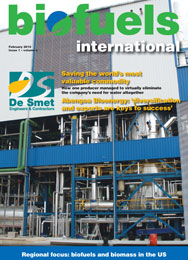
Volume 4, Issue 1
Published: February 4, 2010
Is making ethanol finally cheaper than petrol?
Register or Log In to view this "Free Article"One of the major challenges to the future of the ethanol industry has always been that it cost more to produce than petrol. Future technological advances and cheaper feedstocks were thought to be the solution...
Advancing the German market
Register or Log In to view this "Free Article"Within the EU the German market is not only the biggest it is also an open market for imports – local producers and traders have to compete with other European companies. Additional imports from countries...
An industry in limbo
Like watching a car wreck in slow motion, the US biodiesel industry saw 2009 conclude without an extension for a tax credit critical to the profitability of biodiesel producers. From 31 December to 1 January,...
Abengoa Bioenergy: 'diversification and exports are keys to success'
Register or Log In to view this "Free Article"One of the US’ largest ethanol producers Abengoa Bioenergy has just taken its second step into the export market by shipping the equivalent of 40 railcars at the beginning of January 2010. ‘Exports...
A tale of two walls
It has not been a quiet year for the biofuels industry in the US. Ethanol plants were plagued by a poisonous mix of high raw material costs, low oil prices, and a monster debt they struggled to shift....
Bioenergy plant update - US
Biofuels International provides a list of plants being built across the US...
The potential yield of microalgae oil
In autotrophic microalgae the energy from solar radiation arriving on the microalgal surface is converted into stored biomass by photosynthesis. Unfortunately, not all of the solar energy arriving at the...
An insight into algae
The global economic recession is already shaking out many of the would-be players in a crowded algae space, and favouring new players with improved strategies. Why are some algae companies attracting capital,...
Fuel from sewage?
Since the invention of the flushing toilet and the increased use of baths and showers, sewage now arrives at the treatment part as 95% water. While sewage was just a problem to be disposed hygienically...
Developments in the cellulosic ethanol sector
Cellulose is the most abundant organic compound on earth. Together with hemicellulose and lignin it forms the structure of all plants. Cellulose can be obtained from agricultural and forestry waste, leaves,...
Working together
Cellulosic ethanol is expected to be a major contributor to the biofuels solution, and there are many factors driving this opportunity. The widespread availability of lignocellulosic material – from...
Saving the world’s most valuable commodity
Piedmont Biofuels used to use 1 gallon of water per gallon of biodiesel produced, until the municipal wastewater treatment plant could no longer accept it because it had reached its biological oxygen demand...
Crude glycerine treatment using coalescers
Glycerine is a critical component used in the manufacture of a wide variety of products in the pharmaceutical, cosmetics, and food industries. It is a colourless, non-toxic, viscous fluid and has traditionally...
Added value
Due to a high protein content, biofuel side streams hold a lot of value, which can even exceed the worth of the biofuel itself. For example, soyabeans have 35% protein content, rapeseed – 21%, wheat...
Monitoring glycerine quality
Glycerine is a highly stable non toxic, nonirritating product with no negative environmental effects. Physically, it is watersoluble, clear, colorless, odorless, viscous and hygroscopic liquid with a high...
Biotransformation of glycerine gains momentum
Glycerine is one of the most widely available chemicals in the world, touting a production of over £2 billion (€2.3 billion) and growing.1 As the biodiesel industry well knows, the supply of glycerine...












